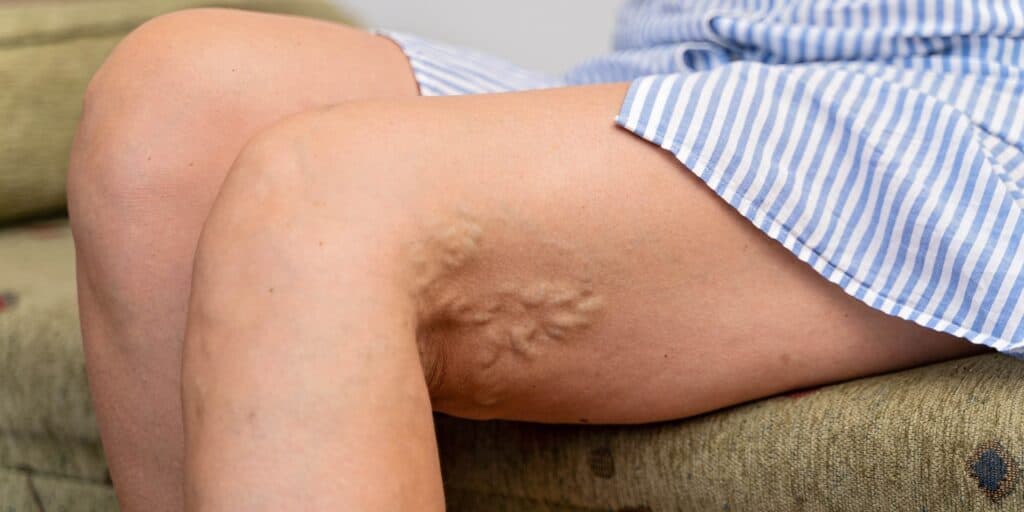Veins are blood vessels that transport deoxygenated blood from organs and muscles back to the heart.
Venous diseases are medical conditions related to your veins, and these include:
- Varicose veins, spider veins. This is a condition whereby the valves in the veins have weakened, thus allowing the backflow of blood. As a result, the veins start to bulge, enlarge and/or twist.
- Deep Vein Thrombosis (DVT). Deep vein thrombosis is a condition in which a blood clot has formed in the deep veins of the body, usually in the limbs and/or arms. This restricts the blood flow through the vein and in addition, it can result in a possibly fatal condition, pulmonary embolism.
- Venous malformations. Venous malformations refer to the abnormal growth of veins in the body, and they appear as skin-coloured soft lumps under the skin.
- Chronic wounds, such as ulcers (usually found on the legs). These chronic wounds are related to poor circulation in the legs, which causes increased venous blood pressure resulting in the formation of open sores.

Prevention methods
The prevention of vein diseases includes both the maintenance of good vascular health as well as prevention techniques to reduce your risk of developing these vein diseases.
Your vascular health refers to your circulatory system, which consists of all the vessels that allow for the transport of blood and lymph around the body. The vascular system is very important to our human body as it is the passageway that allows for the transport of essential substances such as oxygen, nutrients, hormones, carbon dioxide and blood cells around the body. Hence, it is crucial that we protect our vascular health, and here are three simple tips to improve your vascular health:
- Managing underlying health conditions (such as hypertension, diabetes, high cholesterol). It is important that we manage these conditions to prevent them from worsening, as they can affect our vascular health.
- Hypertension, commonly referred to as high blood pressure, can result in damage to the walls of blood vessels, and also contributes to atherosclerosis, the buildup of plaque in the walls of blood vessels, which results in the narrowing and/or blockage of blood vessels.
- Diabetes refers to a condition in which there are high levels of glucose in the bloodstream, which can result in the damage of the walls of blood vessels. It is also a contributing factor of atherosclerosis.
- Cholesterol is one of the main components of the plaque that deposits in the walls of the blood vessels. As such, high levels of cholesterol in the bloodstream heavily contribute to atherosclerosis.
- Refrain from smoking and drinking. Components in smoke such as carbon monoxide and nicotine accelerate the formation of atherosclerosis (buildup of plaque in the walls of blood vessels), resulting in the narrowing of blood vessels. Smoking also causes blood to thicken, which also makes it more prone to blood clots.
You should refrain from drinking as alcohol contains high levels of calories, as well as encourages high blood pressure. As a result, you may find yourself putting on weight if you are a heavy drinker.
- Exercise. Aerobic exercise, for example, walking, jogging, yoga etc. promotes good circulation throughout the body. This is extremely essential to our vascular health as this promotes the flow of blood through blood vessels in our body. In addition, exercise also helps you to maintain a healthy weight, which also makes you less prone to certain diseases, such as hypertension (high blood pressure) and diabetes, which are both contributing factors of atherosclerosis (buildup of plaque in the walls of blood vessels).
On top of protecting your vascular health, here are some tips on how to prevent venous diseases:
- Ways to prevent varicose veins/spider veins
- Exercise regularlyMaintain a healthy weight and lose weight if you mustDo not stand and/or sit for long periods of time and stretch often if you must
- Wear compression stockings to prevent blood from pooling in your legs
- Ways to prevent deep vein thrombosis
- Do not stand and/or sit for long periods of time. It is best to move around to encourage circulation in your body. Stretch often if you must.
- Compression stockings to prevent blood from pooling in your legs
- Exercise frequently
- Maintain a healthy weight and lose weight if you must
- Quit smoking
- Monitor your blood pressure
- Keep hydrated to reduce chances of blood thickening which can make it more prone to blood clots
- There are no specific ways to prevent venous malformations, as this condition is mainly congenital.
- Ways to prevent chronic wounds, such as ulcers (on the leg)
- Exercise regularlyQuit smokingMaintain a healthy weight and lose weight if you mustDo not stand and/or sit for long periods of time. It is best to move around to encourage circulation in your body. Stretch often if you must.Lift your legs for a short while to aid the flow of blood back to your heart, especially if you have been standing and/or sitting for a long period of time.
- Wear compression stockings to prevent blood from pooling in your legs
If you are looking for treatment for venous diseases, head down to our clinic today!
At the Vascular and Interventional Centre, we provide treatment for a range of diseases associated with your veins. You may contact us by calling us at +65 6694 6270 or email us at en*****@***********tr.com
